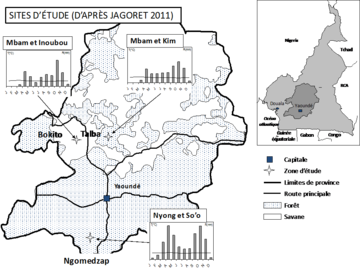Case studies
4013 - full - crd_page - medium
Cameroon
In 2016 two contrasting sites of the Center of Cameroon were studied: Talba and Bokito. In 2017 a third site is added, at Ngomezap and its surroundings.
Bokito is a site where we find old cocoa plantations with complex multi-strata structure, and a species dominance of fruit trees. Originally installed in corridor forests, they extend to the neighboring savannah areas, nibbling the areas reserved for food crops. Talba, a pioneer forest front opened in the early 1980s, brings together very contrasting farm types, from local and migrant populations. The implanted cocoa agroforestry systems are of complex to simple structure, with a species dominance of forest trees. Food systems are diverse, and different from those of Bokito.Ngomezap is a forested site with a local dnamic, at the south of Yaoundé, where cocoa are historical plantations with very complex structure of cocoa, fruit trees and forested trees associations.
Nicaragua
In three municipalities of the provinces Matagalpa and North Atlantic: La Dalia, Waslala and Siuna.
On-farm trees are key resources in the livelihoods of poor rural populations. The importance of studies on trees in agricultural landscapes is increasing and is justified both by its ecological as well as socioeconomic importance. Many efforts have been made globally, in order to quantify and know these trees. However, it is necessary to know what encourages farmers to cultivate them on their farms, especially in the current context of deforestation and expansion of agricultural frontiers. A first study (dos Santos Moreira 2017), developed in the municipalities Waslala and La Dalia, identified the socioeconomic factors that influence the presence of trees on farms in these municipalities. The results showed the strong relationship between local livelihoods and trees, how farmers' perceptions influence tree farming on farms, and the relationship between security over land tenure and the presence of trees on farms.
Madagascar
The study sites are located on the east coast of Madagascar in the region of production of clove called Fénérive-Est.
Two types of agroforestry systems (AFS) are present: cultivated and/or grazed parks, and complex AFS. The clove AFS contain other cash crops (coffee, vanilla, lychee and pepper), many fruit trees, trees for firewood and construction, medicinal plants and plants for various uses. The modeling of farms shows that AFS allows a significant saving for households thanks to the various self-consumed products. It shows a variable sensitivity to fluctuations in cash crop prices depending on the types of AFS and the structural characteristics of the farm, but the diversification of AFS is in favor of a better stability of income and the economic balance of the household.
4013 - full - Contenu des classeurs



